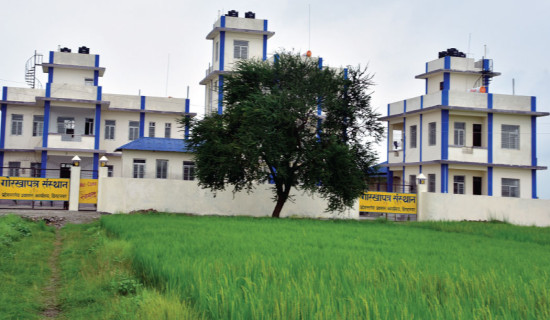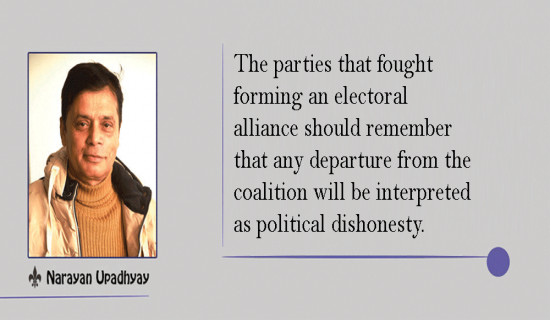- Saturday, 20 December 2025
58thAnniversary Special Supplement
Playing Second Fiddle To Nepali-language Counterparts
Taking advantage of the freedom given by the federal democratic constitution, media of all hues and stripes have flourished enormously in the country over the years. Aside from the traditional media landscape dominated by newspapers (daily, weekly, fortnightly, and monthly), television channels, and radio stations, online media have also increased dramatically in recent years. With the emergence of social media platforms, Nepali media has grown by leaps and bounds.
Although Nepali-language online media has grown since the advent of the internet and online portals, English-language media in the country have settled for second fiddle. Anyone active in English-language media in Nepal can attest that this form of media has not fared better against their Nepali-language media competitors. English-language media has not developed to the same extent as Nepali-language media has, though it has already been over seven decades since the first English-language newspaper was published here.
Decline in readership
English-language media in Nepal, especially newspapers, have confronted a slew of constraints that severely limit their operations and efficacy. With the rise of digital media, which includes online news portals, social networking platforms such as Facebook, X (previously Twitter), YouTube, and TikTok, and the emergence of artificial intelligence, it is the English-language media that has seen a decline in readership in Nepal. Crises of survival have haunted them.
Young people, notably college students and graduates, are the main bastion of readership and are more drawn to online media and social media platforms where they seek news about their interests. The instant gratification provided by these platforms has made them less interested in traditional forms of English-language media in our country, such as newspapers and English-news-based programmes broadcast by radio and television networks. Indeed, with digital media, the country's media that relies on the English language has become less popular. English newspapers in Nepal have less serious readers. Only a few people want to buy and read them. These lots include college teachers, media people, expatriates, diplomats, and officials at international agencies, all of whom are minimal in number compared to the number of Nepali-language media readers. Few airlines, hotels, and restaurants subscribe to the English language media in order to serve foreign consumers.
This could explain why many Kathmandu newsstands are almost devoid of English newspapers, despite being crammed with Nepali newspapers and magazines. Outside of Kathmandu, kiosks selling newspapers negligibly sell English newspapers. The reason for this is that there is no demand for these papers. Several publishing houses would agree that the sale of English-language media is mostly subscription-based.
All English-language newspapers—The Rising Nepal, The Kathmandu Post, The Himalayan Times, The Annapurna Express, and a few English-language weeklies like the People's Review and The Nepali Times—and monthly lifestyle magazines do not sell as well as Nepali newspapers and magazines.
The number of English readers is not as large as the publishers had hoped. The bulk of the population, particularly in urban and rural regions, is not well versed in the English language, limiting the relevance of English-language publications and broadcast media.
Less pages, contents
Another reason English media does not sell in good amounts is that most of these media are not as proficient at publishing news events and disseminating their expert, impartial views on news and views on pressing contemporary topics as their counterparts or sister Nepali newspapers are. A significant difference in the contents of two daily newspapers published by the same outlets makes the disparity between the sister publications evident. If we look closely at Kantipur Daily, the Kathmandu Post, the Annapurna Express, and the Annapurna Post, we can witness this disparity.
Pages in English newspapers are also lower than in Nepali-language newspapers. For example, Gorkhapatra Daily is published with around 20 pages on certain days, whereas the paper publishes 12 to 16 pages every day because of the large amount of advertisement material received. The Rising Nepal, on the other hand, is published with eight pages and the paper’s special supplement with four pages every Friday. The Kathmandu Post usually has eight pages and sometimes has twelve, while Kantipur comes out daily with 12 to 16 pages and sometimes with 20 pages.
The Himalayan Times, which was formerly very appealing because it used to be published with extra page supplements almost every day during its initial years, has adopted the same method of lessening its number of pages. The number of pages in the English newspaper shrank with the outbreak of COVID-19, which reduced the income of publishing houses, forcing them to lower the number of pages in their papers. The Republica daily is one example of an extreme outcome: the publishing house folded the Republica’s newspaper version and limited it to its online version following COVID-19.
Publishing houses have yet to increase the number of pages or return their papers to the former format. The lesser number of pages and content must have discouraged readers from buying these papers. If this is the issue, a question arises in our minds: If English-language media have failed to generate the anticipated level of income, why are they still published? Many English-language media are published or broadcast on the earnings of their sister publications; mostly the Nepali-language media provide an answer to this issue. The circulation of English newspapers is significantly lower than that of their Nepali counterparts. Moreover, despite losses, the publishing firms continue to publish English-language newspapers and broadcast English-language news-based shows in order to remain viable and competitive in the country's media market. The English-language media complements their already popular Nepali-language media.
Scarcity of expert hands
Another challenge for English-language media in Nepal is the scarcity of qualified English-language journalists. Although English is taught in schools and colleges, the level of fluency required for professional journalism is sometimes insufficient. This is a huge impediment to maintaining the inflow of competent journalists. Meanwhile, media owners fail to do justice when it comes to giving generous pay and benefits to English-language media journalists. As a result, young people who aspire to work as journalists in English-language media sometimes opt for greener pastures, such as international organisations or government departments.
Furthermore, the increasing rise of digital media channels has compounded matters. While these platforms provide greater reach and accessibility, they also present their own set of issues. English-language media outlets here have struggled to adapt to the digital landscape, lacking the resources needed to compete with online news platforms known for providing information with speed and agility.
Adjustment to changing times
The struggle of English-language media in Nepal is a reason for concern, since it undermines the country's ability to offer accurate and reliable information to its residents and the international community effectively.
The future of English-language media in Nepal does not appear bright at the moment. It has been stuck and has not found a way out of the current situation.
To solve the issues faced by the English-language media in Nepal, additional investment and assistance from both the government and private sectors are required. Publishing houses, too, must adjust to changing times and endeavour to find expert and competent hands to manage the new problems.
This can help strengthen infrastructure, boost reporting quality, and provide better training opportunities for prospective English-language journalists. Additionally, efforts should be made to create talented journalists capable of generating high-quality content so that the English-language media not only thrives but also earns its own place to be competitive with their rivals, the Nepali-language media.
(The author is a former managing editor of this daily.)

















